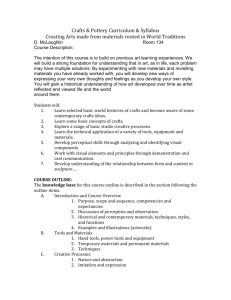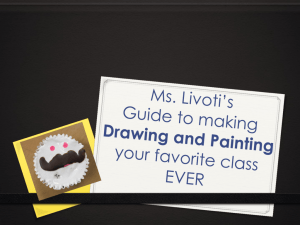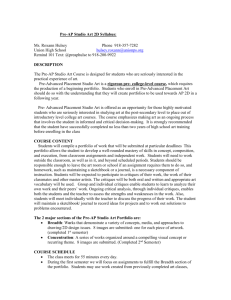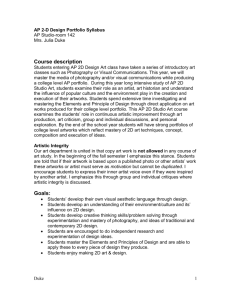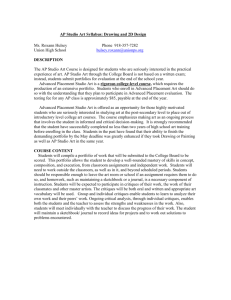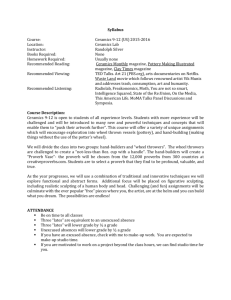Advanced Placement Studio Art: Drawing
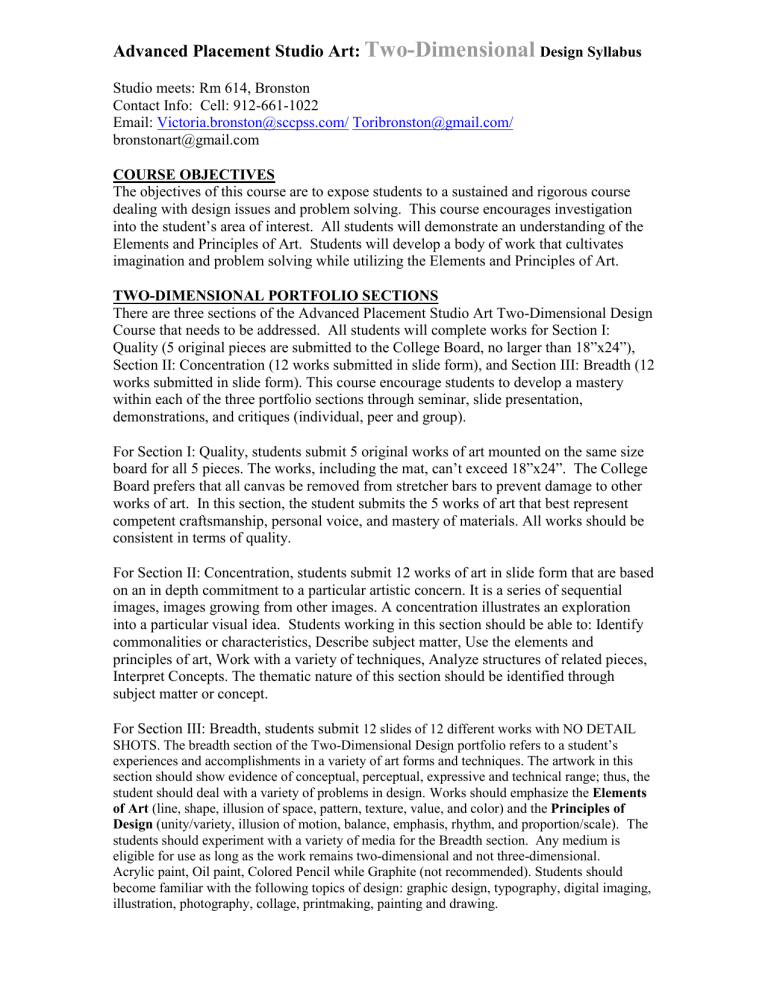
Advanced Placement Studio Art:
Two-Dimensional
Design Syllabus
Studio meets: Rm 614, Bronston
Contact Info: Cell: 912-661-1022
Email: Victoria.bronston@sccpss.com/ Toribronston@gmail.com/ bronstonart@gmail.com
COURSE OBJECTIVES
The objectives of this course are to expose students to a sustained and rigorous course dealing with design issues and problem solving. This course encourages investigation into the student’s area of interest. All students will demonstrate an understanding of the
Elements and Principles of Art. Students will develop a body of work that cultivates imagination and problem solving while utilizing the Elements and Principles of Art.
TWO-DIMENSIONAL PORTFOLIO SECTIONS
There are three sections of the Advanced Placement Studio Art Two-Dimensional Design
Course that needs to be addressed. All students will complete works for Section I:
Quality (5 original pieces are submitted to the College Board, no larger than 18”x24”),
Section II: Concentration (12 works submitted in slide form), and Section III: Breadth (12 works submitted in slide form). This course encourage students to develop a mastery within each of the three portfolio sections through seminar, slide presentation, demonstrations, and critiques (individual, peer and group).
For Section I: Quality, students submit 5 original works of art mounted on the same size board for all 5 pieces. The works, including the mat, can’t exceed 18”x24”. The College
Board prefers that all canvas be removed from stretcher bars to prevent damage to other works of art. In this section, the student submits the 5 works of art that best represent competent craftsmanship, personal voice, and mastery of materials. All works should be consistent in terms of quality.
For Section II: Concentration, students submit 12 works of art in slide form that are based on an in depth commitment to a particular artistic concern. It is a series of sequential images, images growing from other images. A concentration illustrates an exploration into a particular visual idea.
Students working in this section should be able to: Identify commonalities or characteristics, Describe subject matter, Use the elements and principles of art, Work with a variety of techniques, Analyze structures of related pieces,
Interpret Concepts. The thematic nature of this section should be identified through subject matter or concept.
For Section III: Breadth, students submit 12 slides of 12 different works with NO DETAIL
SHOTS. The breadth section of the Two-Dimensional Design portfolio refers to a student’s experiences and accomplishments in a variety of art forms and techniques. The artwork in this section should show evidence of conceptual, perceptual, expressive and technical range; thus, the student should deal with a variety of problems in design.
Works should emphasize the Elements of Art (line, shape, illusion of space, pattern, texture, value, and color) and the Principles of
Design (unity/variety, illusion of motion, balance, emphasis, rhythm, and proportion/scale). The students should experiment with a variety of media for the Breadth section. Any medium is eligible for use as long as the work remains two-dimensional and not three-dimensional.
Acrylic paint, Oil paint, Colored Pencil while Graphite (not recommended). Students should become familiar with the following topics of design: graphic design, typography, digital imaging, illustration, photography, collage, printmaking, painting and drawing.
CRITIQUES
You will learn a great deal from your peers. The most effective means of studio discussions occur with critiques. Critiques are always meant to be constructive with the intent to encourage growth of all artists. It is imperative that you become comfortable with and actively participate in critiques. YOU WILL NOT GAIN ANYTHING FROM
THESE CRITIQUES IF YOU DON’T OFFER YOUR OPINIONS. You will be graded for your participation in critiques. There are several types of critiques that we will have this year: Class critiques evaluating individual assignments, class critiques evaluating entire portfolios, peer critiques, teacher and individual student critique/conference evaluating assignments, portfolio or concentration, and Gallery Walks.
Important topics to cover during critiques include: Strengths of artist, Areas for improvement, Works that most effectively capture the viewer’s attention, and Works that most effectively communicate ideas and attitudes about the issue explored. You will find that gaining constructive feedback from the teacher as well as your classmates make for a more fulfilling artistic experience.
ASSESSMENT
You will be assessed in a variety of ways this year in Advanced Placement Studio Art.
Each student will be assessed on every project, on the portfolio as a whole, the use of his/her process book, writing and research for the Concentration, the quality of the slides, slide presentations, mid-term exam, final exam, participation in the class during critiques and lab time. Your mid-term and final exam will be portfolio presentations in front of the class. The mid-term exam will be a slide presentation and the final exam will be a powerpoint portfolio presentation. All students will be required to do self-assessments for every project.
The College Board selects a group of judges called “readers” to score each portfolio. The readers are made up of college professors and high school art teachers. They are given a specific rubric to follow to help them score your artwork fairly. You can find the rubric on the College Board website under AP Studio Art
There are 10 important areas that I will use to grade your artwork in the classroom. These correspond with the AP College Board rubric.
CREATIVE THOUGHT - Think higher learning skills: Analysis, Synthesis, Fluency, Flexibility, Elaboration and
Evaluation through “Thumbnailing” and “Brainstorming”.
CONTRAST - Strong difference - pushing value, color and other elements to the limits!
COMPOSITION - No bulls eye effects. Asymmetry more than symmetry. Vary compositional formats.
COMPELLING CONTENT - A conceptual search for underlying meaning producing eye-catching, thought provoking and intriguing art work that makes a statement causing the viewer to THINK as well as observe!
CAPABLE CRAFTSMANSHIP - Work that is clean, clearly presented and shows control of chosen medium. The viewer observes that the artist understands the media, its uses, and application.
CLEAR AND CONCISE INTENT -
The artistic statement is apparent and the viewer realizes that the artist has accomplished their intended goals.
CATCH AND CONTROL THE VIEWER’S EYE - Catch the viewer’s interest and control the eye movement in the work.
CONFIDENT - A sense of adventure and willingness to experiment and take risks.
COLOR - Strong and innovative color use. Avoid using a rainbow of colors and/or limiting oneself to standard color schemes.
COPIED WORK? NO! NO!
NO!
RATING SCALE : 70-76/ D below 1 Not Satisfactory
77-84/C 2 Needs work to bring up to standard
85-92/B 3 Acceptable
93-96/A 4 Well done
97-100/ A 5 Of Exceptional Quality
Teacher Assessment Qualities
Creative Thought (1-10)
Contrast (1-10)
Student Self-Assessment
Composition (1-10)
Compelling Content (1-10)
Capable Craftsmanship (1-10)
Clear and Concise Intent (1-10)
Catch and Control the Viewer’s
Eye (1-10)
Confident (1-10)
E&P of Design ( 1-10)
Originality (1-10)
PLAGARISM AND ORIGINALITY
It is perfectly acceptable to be inspired by other artists and use photographic references.
It is also acceptable to do a study of another artist’s work to exercise your skills. It is not acceptable, however to use another artist’s images or ideas for artwork, and turn it in for the Advanced Placement Studio Art exam, use for a grade for the class, or put your name on it and claim it as your own. An exercise is just that, it is only designed to help you practice. Anytime you use another artist’s composition, color scheme, and imagery it is considered plagiarism. Copying from another person’s photograph is easy and illegal.
Almost anyone can copy from a photograph. How much thought are you really putting into a work of art if you simply copy from a photograph. You have to put in the effort to change the original artist’s intentions considerably. My rule is you must change 70% of the composition and imagery to be accepted for a grade. COPIED WORK IS A NO!
NO! NO! You can use photographs you have taken because you chose the composition behind the camera lens.
MATERIALS AND RESOURCES USED
In this class we will utilize a variety of artistic media for each project. We will also use slides, a slide projector, College Board Advanced Placement Studio Art slide examples, previous years slide examples, a light table, computers with Adobe Photoshop, scanners,
Powerpoint, CD’s, the kiln, and pottery wheels. I have collected a variety of art history, and books on techniques in art that students may use throughout the year. I also have one bookshelf dedicated to art periodicals that students can peruse.
Students are required to use Process Books on a regular basis. Students are required to purchase a hardback sketchbook (no smaller than 9x12). The process book will serve as a place to draw, collect images and execute all preparatory sketches for finished works. It
also may contain research, writing and notes from classroom discussion. Students are required to complete 25 pages per quarter.
Recommended AP Art Supplies:
Artbin or tackle box with your name on the front
Small set of oil paints
Set of synthetic paintbrushes of varying sizes
Odorless mineral spirits
Set of watercolor pencils
Set of colored pencils (prismacolor is recommended)
#2, #4, #6 General’s Charcoal pencils
Hard cover 9x12 sketchbook (bring with you the first day of school)
Drawing pencils varying in hardness 2H-9B
Sharpie markers and ink pens, fine and medium tip
20”x 26” portfolio carrying case with a strap (you can also make your own, I’ll show you how) magic rub erasers gummy erasers
Art books to guide your journey
PROCESS BOOKS: A New Way to Use Your Sketchbooks
Until now, your sketchbooks have been used to complete finished drawing assignments that you turned in for a grade. This year you will use your sketchbook differently as it will be called your process book . Yes, you can do as many drawings as you want in your process book , in fact I recommend you continue drawing in your sketchbook. But this year I want you to purchase a hardcover sketchbook and NEATLY fill it with ideas, drawings and notes for projects. The best process books are the hardback sketchbooks with a sewn binding.
Books have always been a valuable source of visual documentation for the art teacher and student of art. You will use this process book to convey your interests and intentions for projects. I want you to work in your process book on a daily basis (even if it is only for 5-
10 min.) Occasionally, do an observation drawing to keep up your skills.
Try contour line, gesture sketches and completed value drawings with strong darks and lights.
Just as an athlete must exercise each day to play well, so must the artist.
Don’t think of your
Decorate your cover with something unique, and any type of sketchbook will work. process book as a place for assignments anymore, use it as a source of inspiration. Work in your process book often, making thumbnail sketches of ideas and things that you see to inspire you, lists of materials you want to work with, color combinations, etc.
You will have 25 pages due every nine weeks during the school year.
BIBLIOGRAPHIC INFORMATION
The textbooks that we will use in this class are as follows:
Design Basics, Multimedia Edition
David Lauer, Stephen Pentak
6th Edition
Design Through Discovery : The Elements and Principles
Marjorie Elliot Bevlin
2 nd Editon
MAJOR ASSIGNMENTS, TOPICS, PROJECTS
This year you will create:
12 works for Concentration
12 works for Breadth
5 works for Quality
29 works Total
You have approximately one work of art due a week. This means homework, weekends and holidays. If you have a tendency to work slow, then work smaller in the beginning.
Don’t worry you will soon develop a faster pace.
LATE WORK WILL NOT BE ACCEPTED!
RE-EVALUATION POLICY
Many times artists feel that they may need to revisit their work to improve it. If you have already turned in your project for a grade, but have made significant improvements, you may re-submit your artwork to me to re-grade as long as it is turned in within the same nine week period.
Sources for Inspiration
THIS SUMMER AND THROUGHOUT THE SCHOOL YEAR VISIT MUSEUMS, ART GALLERIES,
SHOPS, ARTISTS' STUDIOS, COLLEGE ART DEPARTMENTS, ETC. AND PICK UP BROCHURES,
POST CARDS, ARTISTS' STATEMENTS, AND MATERIALS ABOUT EXHIBITS. PICK UP ARTIST’S
MAGAZINES AND CUT OUT WORKS THAT YOU REALLY LIKE. CAREFULLY AND NEATLY PASTE
THESE IN YOUR PROCESS BOOK. MAKE NOTES AND SKETCHES OF HOW YOU CAN USE SOME
OF THESE IDEAS IN A PROJECT. THIS MATERIAL MAY BE THE INSPIRATION FOR PROJECTS
YOU WILL WORK ON DURING THE YEAR .
“Art is an idea. It is not enough to draw, paint, and sculpt. An artist should be able to think.”
-Gurdon Woods
